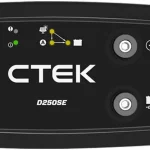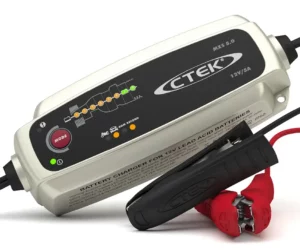
Ctek MXS 5.0 Battery Charger User Manual
CONGRATULATIONS
to the purchase of your new professional switch mode battery charger. This charger is included in a series of professional chargers from CTEK SWEDEN AB and represents the latest technology in battery charging. 
CHARGING WITH MULTI OPTIONS
- Connect the charger to the battery
- Conned the charger to the well socket
- Press the MODE button to select charging program NORMAL BATTERYрогостам
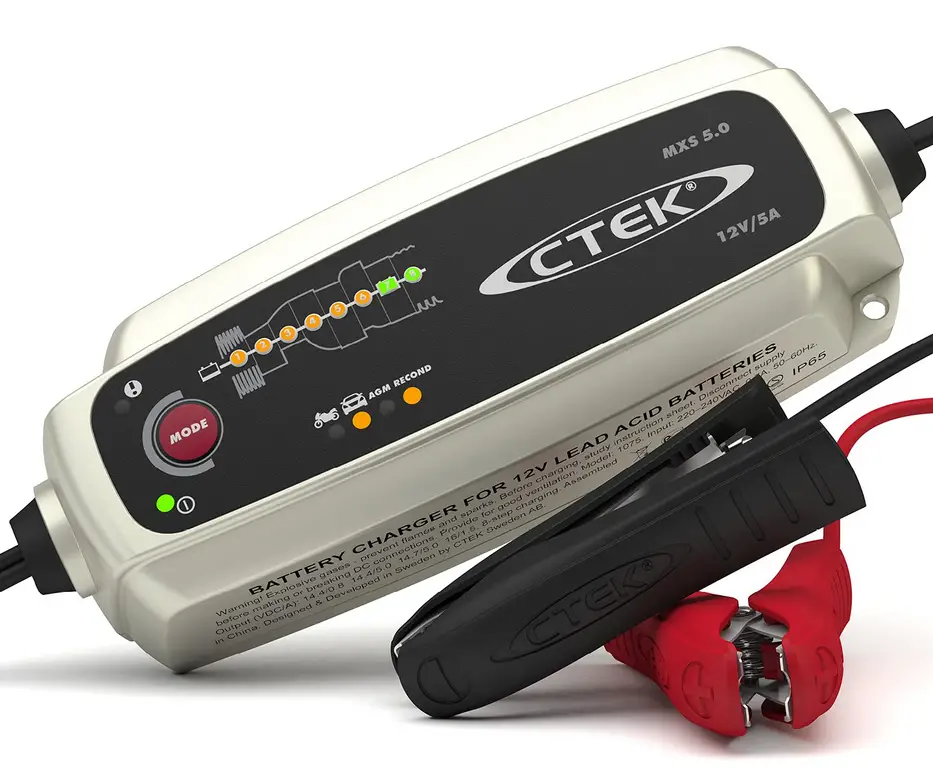
- Follow the 8-step display through the charging process. The battery is ready to start the engine when STEP 4 is lit. The battery is fully charged when STEP 7 is lit.
- Stop charging at any time by disconnecting the mains cable from the wall socket.
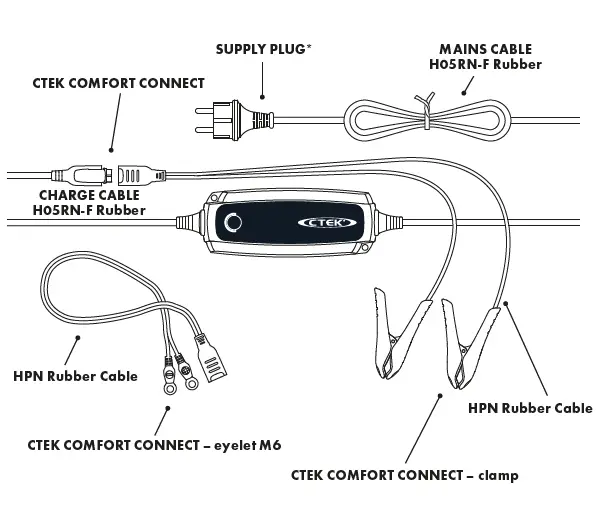
CHARGING PROGRAMS AND OPTIONS
Press the MODE-button to select between the charging programs and to add charging options. The LEDs will indicate which programs and options that are selected. The selected program will be memorised and restarted next time the charger is connected.
The table explains the different Charging Programs:
Charging Options
If the error lamp is lit, check the following:
- Is the chargers positive lead connected to the battery´s positive pole?
- Is the charger connected to a 12V battery?
- Has charging been interrupted in STEP 1, 2 or 5?
Restart the charger by pressing the MODE-button. If charging is still being interrupted, the battery…- STEP 1: …is seriously sulphated and may need to be replaced.
- STEP 2: …cannot accept charge and may need to be replaced.
- STEP 5: …cannot keep charge and may need to be replaced.
POWER LAMP
If the power lamp is lit with a:
- STEADY LIGHT
The mains cable is connected to the wall socket. - FLASHING LIGHT:
The charger has entered the energy save mode. This happens if the charger isn´t connected to the battery in 2 minutes.
READY TO USE
The table shows the estimated time for empty battery to 80% charge
CHARGING PROGRAMS AND OPTIONS COMBINATIONS
CHARGING STEPS
STEP 1 DESULPHATION
Detects sulphated batteries. Pulsing current and voltage, removes sulphate from the lead plates of the battery restoring the battery capacity.
STEP 2 SOFT START
Tests if the battery can accept charge. This step prevents that charging proceeds with a defect battery.
STEP 3 BULK
Charging with maximum current until approximately 80% battery capacity.
STEP 4 ABSORPTION
Charging with declining current to maximize up to 100% battery capacity.
STEP 5 ANALYSE
Tests if the battery can hold charge. Batteries that cannot hold charge may need to be replaced
STEP 6 RECOND
Choose the Recond option to add the Recond step to the charging process. During the Recond step voltage increases to create controlled gassing in the battery. Gassing mixes the battery acid and gives back energy to the battery.
STEP 7 FLOAT
Maintaining the battery voltage at maximum level by providing a constant voltage charge.
STEP 8 PULSE
Maintaining the battery at 95-100% capacity. The charger monitors the battery voltage and gives a pulse when necessary to keep the battery fully charged.
CONNECT AND DISCONNECT THE CHARGER TO A BATTERY
INFO
If the battery clamps are incorrectly connected, the reverse polarity protection will ensure that the battery and charger are not damaged.
For batteries mounted inside a vehicle
- Connect the red clamp to the battery’s positive pole.
- Connect the black clamp to the vehicle chassis remote from the fuel pipe and the battery.
- Connect the charger to the wall socket
- Disconnect the charger from the wall socket before disconnecting the battery
- Disconnect the black clamp before the red clamp.
Some vehicles may have positively earthed batteries.
- Connect the black clamp to the battery’ snegative pole.
- Connect the red clamp to the vehicle chassis remote from the fuel pipe andthe battery.
- Connect the charger to the wall socket
- Disconnect the charger from the wall socket before disconnecting the battery
- Disconnect the red clamp before the black clamp.
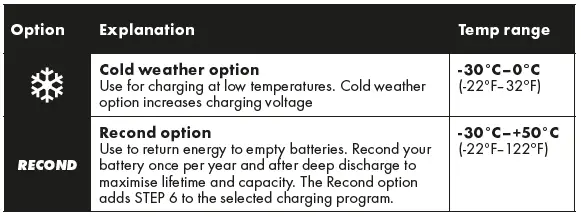
TECHNICAL SPECIFICATIONS
- Back current drain is the current that drains the battery if the charger is not connected to the mains. CTEK chargers has a very low back current.
- The quality of the charging voltage and charging current is very important. A high current ripple heats up the battery which has an aging effect on the positive electrode.
- High voltage ripple could harm other equipment that is connected to the battery. CTEK battery chargers produce very clean voltage and current with low ripple.
SAFETY
- The charger is designed for charging only for batteries according to the technical specification. Do not use the charger for any other purpose. Always follow battery manufacturers recommendations.
- Never try to charge non rechargeable batteries.
- Check the charger cables prior to use. Ensure that no cracks have occurred in the cables or in the bend protection. A charger with damaged cord must be returned to the retailer. A damaged mains cable must be replaced by a CTEK representative.
- Never charge a damaged battery.
- Never charge a frozen battery.
- Never place the charger on top of the battery when charging.
- Always provide for proper ventilation during charging.
- Avoid covering the charger.
- A battery being charged could emit explosive gasses. Prevent sparks close to the battery. When batteries are reaching the end of their lifecycle internal sparks may occur.
- All batteries fail sooner or later. A battery that fails during charging is normally taken care of by the chargers advanced control, but some rare errors in the battery could still exist. Don’t leave any battery during charging unattended for a longer period of time.
- Ensure that the cabling does not jam or comes into contact with hot surfaces or sharp edges.
- Battery acid is corrosive. Rinse immediately with water if acid comes into contact with skin or eyes, seek immediate medical advice.
- Always check that the charger has switched to STEP 7 before leaving the charger unattended and connected for long periods. If the charger has not switched to STEP 7 within 50 hours, this is an indication of an error. Manually disconnect the charger.
- Batteries consume water during use and charging. For batteries where water can be added, the water level should be checked regularly. If the water level is low add distilled water.
- This appliance is not designed for use by young children or people who cannot read or understand the manual unless they are under the supervision of a responsible person to ensure that they can use the battery charger safely. Store and use the battery charger out of the reach of children, and ensure that children cannot play with the charger.
- Connection to the mains supply must be in accordance with the national regulations for electrical installations.
LIMITED WARRANTY
CTEK SWEDEN AB, issues this limited warranty to the original purchaser of this product. This limited warranty is not transferable. The warranty applies to manufacturing faults and material defects for 5 years from the date of purchase. The customer must return the product together with the receipt of purchase to the point of purchase. This warranty is void if the battery charger has been opened, handled carelessly or repaired by anyone other than CTEK SWEDEN AB or its authorised representatives. One of the screw holes in the bottom of the charger is sealed. Removing or damaging the seal will void the warranty. CTEK SWEDEN AB makes no warranty other than this limited warranty and is not liable for any other costs other than those mentioned above, i.e. no consequential damages. Moreover, CTEK SWEDEN AB is not obligated to any other warranty other than this warranty.
SUPPORT
CTEK offers a professional custom support: www.ctek.com.
For latest revised user manual see www.ctek.com.
By e-mail: [email protected],
by telephone: +46(0) 225 351 80,
by fax +46(0) 225 351 95.
